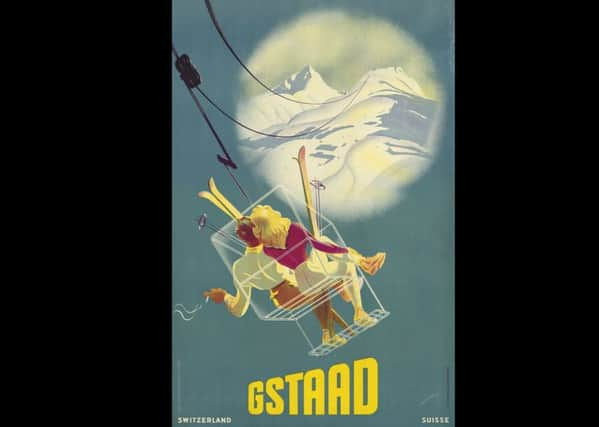Vintage ski posters to go under the hammer at Edinburgh auction


Peikert’s image is expected to fetch between £5,000 and £7,000 when it goes under the hammer tomorrow evening, as part of Lyon and Turnbull’s annual Edinburgh Ski Sale, held in association with vintage poster specialists Tomkinson Churcher. Celebrating the golden age of travel, from the turn of the 20th century through to the 1950s, the auction will feature approximately 70 poster lots, with estimates ranging from £300 to £9,000.
According to Sophie Churcher of Tomkinson Churcher, while the ski industry itself is going through a challenging time, not least thanks to the effects of global warming, the market for vintage ski posters remains healthy. There are even companies like Pullman Editions which now commission contemporary artists to make new posters in the classic style.
Advertisement
Hide AdAdvertisement
Hide Ad“The market for ski posters continues to grow,” she says, “as collectors and decorators look for creative and interesting ways to decorate their ski chalets and homes. The posters so perfectly convey the spirit of the sport, which is one of the reasons they are so sought after.”
Churcher cites Peikert as one of the more significant artists featured in the auction. Born in 1901 in the Swiss town of Zug, he studied at the Ecole des Beaux-Arts in Geneva and worked as an advertising illustrator until he graduated in 1921. From 1925 to 1927 he worked as a designer on the newspaper Wochenschau, and from 1927 he worked as a freelance graphic artist and painter. By the 1940s he had moved to French-speaking Switzerland, where he created tourism posters for the Valais and the Bernese Oberland.
There are a number of Peikert’s posters featured in the sale, with estimates ranging from £2,000 to £9,000. According to Churcher he is “highly sought after for his clear, memorable style which was greatly influenced by Art Deco.”
Other notable Swiss poster artists whose work features in the auction are Herbert Leupin, Otto Baumberger, Emil Cardinaux and Alex Walter Diggelman. “His style is more painterly than Peikert’s,” Churcher says of Diggelman, “and his work conveys a romantic view of life in Switzerland in the 30s and 40s.”
In the ski poster market, however, there’s more at play than artists’ reputations. For a start, posters featuring skiers seem to sell for more than posters with generic views of mountains or resorts. Churcher confirms that, “generally speaking” there is more demand for posters featuring active skiers, although she maintains that the particular resort that the posters promotes is also an important factor for many collectors. And then there’s the vexed question of nationality.
“We usually see Swiss posters fetch the highest prices at auction,” she says. “This is in part due to the glamour and popularity of Swiss resorts, but also because Swiss artists were exceptionally good at capturing the essence of Swiss alpine scenes and holidays. However, we do include posters that promote resorts from all over the world and we find that French, Austrian, Italian and Norwegian posters are also in high demand.”
So what are the magic ingredients that make a great ski poster?
Advertisement
Hide AdAdvertisement
Hide Ad“Collectors love to see colourful, bold posters that demonstrate the pure joy of skiing,” says Churcher. “That could be a dynamic skiier racing down the slopes, or it might be a glamorous apres ski alpine scene. As you might expect, some posters are rarer than others, so this will also affect the interest at auction.
“Finally, resort is still one of the most important elements that will drive up the price of a poster. Places like Gstaad, Davos, Klosters and St Moritz will always see lots of bidding activity.”
For more information, see www.lyonandturnbull.com